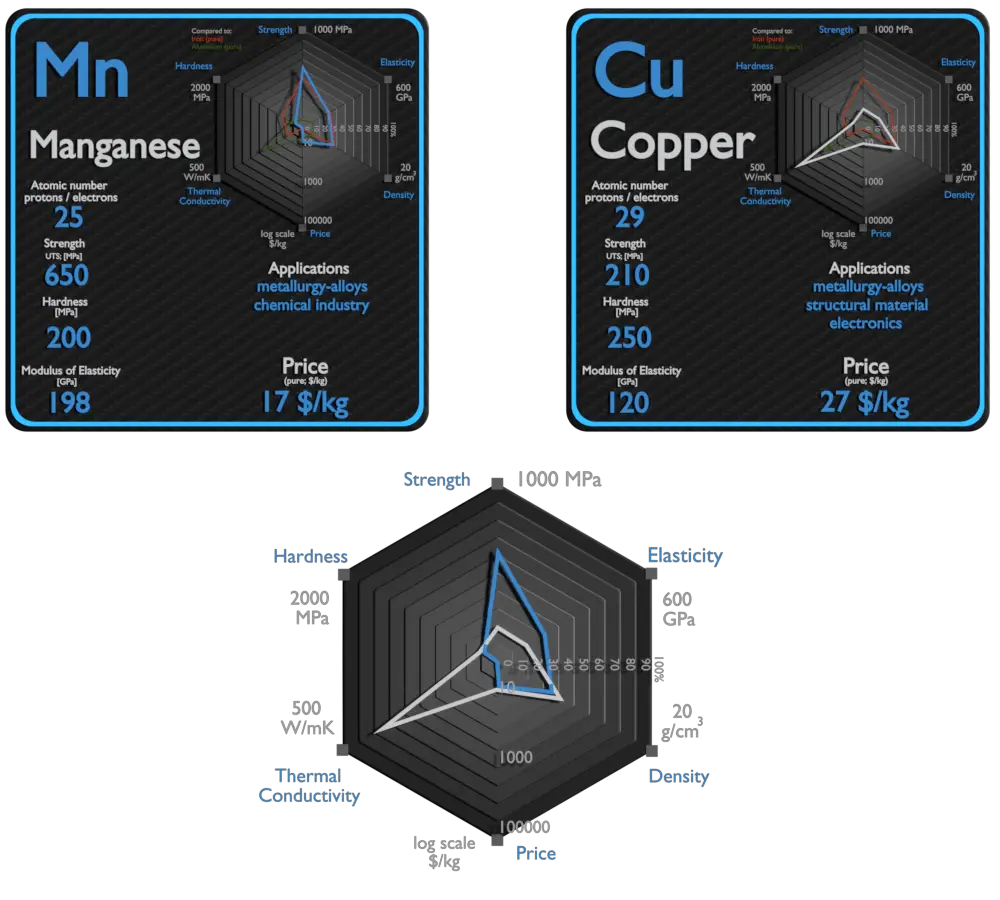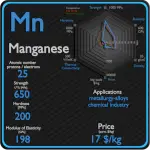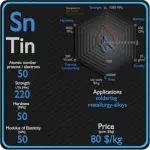This article contains comparison of key thermal and atomic properties of manganese and copper, two comparable chemical elements from the periodic table. It also contains basic descriptions and applications of both elements. Manganese vs Copper.

Manganese and Copper – About Elements


Source: www.luciteria.com
Manganese and Copper – Applications
Manganese
Manganese is an important alloying agent. Almost 90% of the manganese produced annually is used in the production of steel. In steels, manganese improves the rolling and forging qualities, as well as strength, toughness, stiffness, wear resistance, hardness and hardenability. The second largest application for manganese is in aluminium alloys. Aluminium with roughly 1.5% manganese has increased resistance to corrosion through grains that absorb impurities which would lead to galvanic corrosion. Manganese can be formed into many useful compounds. For example, manganese oxide, which can be used in fertilizers and ceramics.
Copper
Historically, alloying copper with another metal, for example tin to make bronze, was first practiced about 4000 years after the discovery of copper smelting, and about 2000 years after “natural bronze” had come into general use. An ancient civilization is defined to be in the Bronze Age either by producing bronze by smelting its own copper and alloying with tin, arsenic, or other metals. The major applications of copper are electrical wire (60%), roofing and plumbing (20%), and industrial machinery (15%). Copper is used mostly as a pure metal, but when greater hardness is required, it is put into such alloys as brass and bronze (5% of total use). Copper and copper-based alloys including brasses (Cu-Zn) and bronzes (Cu-Sn) are widely used in different industrial and societal applications. Some of the common uses for brass alloys include costume jewelry, locks, hinges, gears, bearings, ammunition casings, automotive radiators, musical instruments, electronic packaging, and coins. Bronze, or bronze-like alloys and mixtures, were used for coins over a longer period. is still widely used today for springs, bearings, bushings, automobile transmission pilot bearings, and similar fittings, and is particularly common in the bearings of small electric motors. Brass and bronze are common engineering materials in modern architecture and primarily used for roofing and facade cladding due to their visual appearance.
Manganese and Copper – Comparison in Table
| Element | Manganese | Copper |
| Density | 7.47 g/cm3 | 8.92 g/cm3 |
| Ultimate Tensile Strength | 650 MPa | 120 MPa |
| Yield Strength | 230 MPa | 33 MPa |
| Young’s Modulus of Elasticity | 198 GPa | 120 GPa |
| Mohs Scale | 6 | 3 |
| Brinell Hardness | 200 MPa | 250 MPa |
| Vickers Hardness | N/A | 350 MPa |
| Melting Point | 1246 °C | 1084.62 °C |
| Boiling Point | 2061 °C | 2562 °C |
| Thermal Conductivity | 7.82 W/mK | 401 W/mK |
| Thermal Expansion Coefficient | 21.7 µm/mK | 16.5 µm/mK |
| Specific Heat | 0.48 J/g K | 0.38 J/g K |
| Heat of Fusion | 12.05 kJ/mol | 13.05 kJ/mol |
| Heat of Vaporization | 266 kJ/mol | 300.3 kJ/mol |













